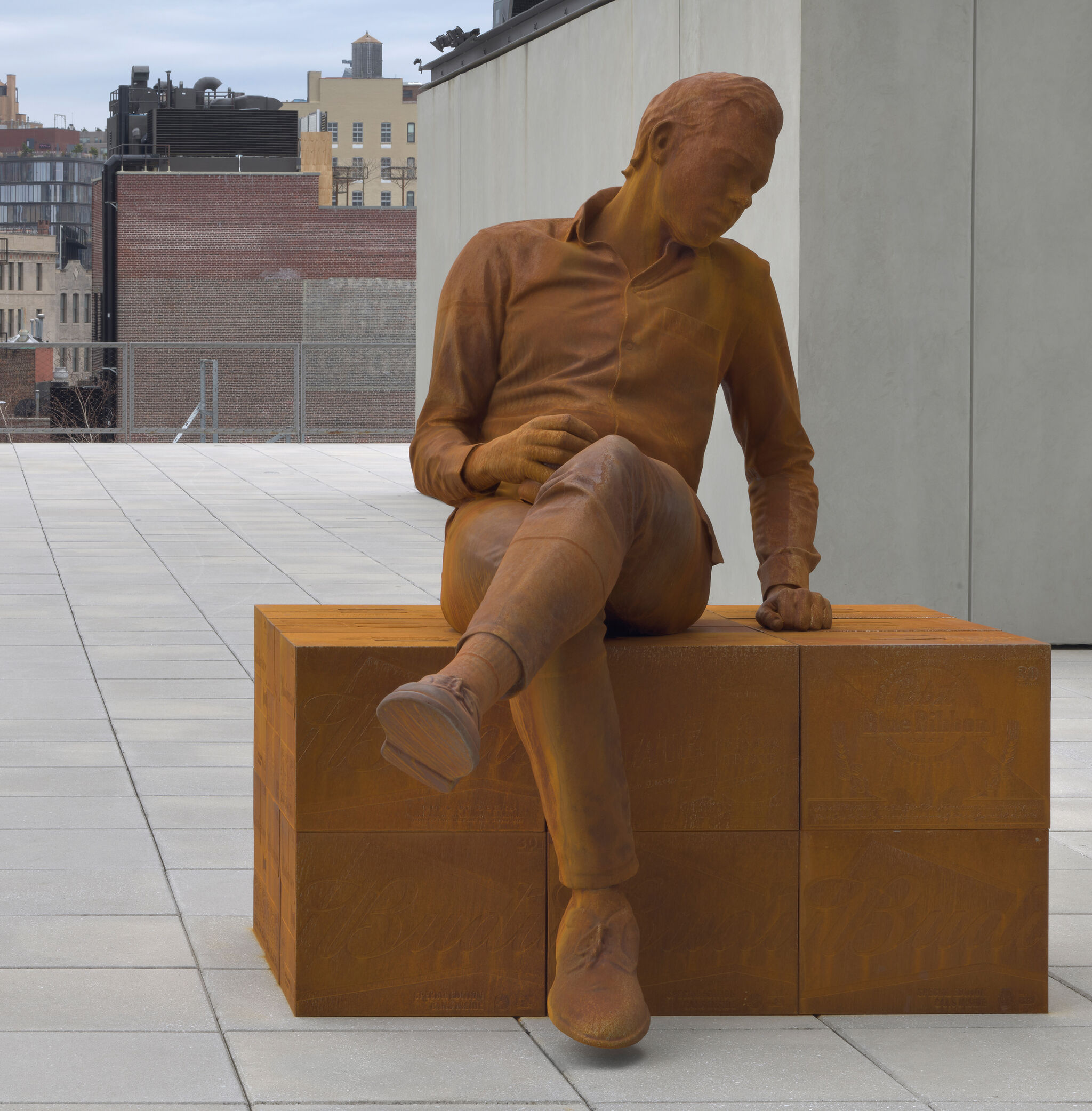Whitney Biennial 2022: Quiet as It’s Kept | Art & Artists
Apr 6–Oct 16, 2022
Whitney Biennial 2022: Quiet as It’s Kept | Art & Artists
Charles Ray
48
Floor 5 Terrace
Born 1953 in Chicago, IL
Lives in Los Angeles, CA
This installation features three new sculptures by Charles Ray: a blankly staring man, a man eating a burger, and a drunken man. Carved from stainless steel, steel, and cast in bronze and painted, these sculptures combine cutting-edge technology and skilled handwork. He works slowly and meticulously, often spending years on each sculpture. His figures are both extremely specific and archetypal. But the sculptures can also be read as emblems of our historical moment: drug-altered, precariously employed, drunk on beer and debt. Ray, an inveterate walker, has described a daily routine that informs his thinking: “I go to Burger King every day, not to eat but to think. I went to one in Madrid at four in the morning; it’s just like the one in LA, identical. Who is there, and what are they being promised? Jean Gesner Henry (aka Coupé Cloué), the Haitian leader of the band Trio Select, said in an interview that money never falls into a poor man’s pocket.”
Ninety-Nine Bottles of Beer on the Wall, 2021
-
Charles Ray, Burger
0:00
Charles Ray, Burger
0:00
Narrator: Charles Ray’s process is painstaking and slow. For the three sculptures here on the terrace, Ray discussed a range of references from a 1950s psychiatric experiment involving people with schizophrenia to the people he saw at the crack of dawn at the Burger King in his neighborhood.
Charles Ray: I sent my casting director, who helps me find models for sculptures and whatnot. And he went and volunteered for a year in a needle exchange program downtown Los Angeles and just got to know the local people.
Narrator: That interaction eventually led to Ray concentrating on the piece here titled Jeff, of a figure staring into space. He increased the scale, in an effort to raise Jeff to something more profound.
Charles Ray: I kind of see him, in a certain sense, as a modern mocking of Christ. He’s just sitting on a box very down and out, very dejected, but I think the scale, in a certain sense, brings an abstraction to it where the equation can move. And in a certain sense, the soul of the sculpture, I wouldn’t even say push, but move back to you rather than you constantly moving into it with empathy. And I guess if there’s any divinity in it, it lies in that equation somewhere. So, that was always going on. It just was finished recently.
Narrator: Now turn to the seated figure eating a burger. Ray found inspiration for this piece on his early morning walks, when he would stop in to a local Burger King.
Charles Ray: I was in there every morning around 7:00 am, between seven and eight, I’d spend ten minutes then. I’d go in the front door, then out the side door. And I realized that people were really interested in their hamburgers, in their Burger King, in their food, in their fries. And it was a moment of really great importance and pleasure to them. And some would wear the crowns, and it brought me to the question of, it was a meta question, who is the king? It was something I started thinking about.
And I found a model, it was a UPS driver, and I made a sculpture of him concentrating on his burger, so he was sitting on a stool, eating his hamburger and concentrating on it. There is like an almost Eastern contemplation going on. It’s almost like a Buddha.
Narrator: The third sculpture in the trio depicts a drunk student.
Charles Ray: Then I was at the Getty and the Getty had just recently acquired a drawing of a drunk peasant. And he was just so drunk, and the drawing was about his drunkenness. He was so drunk, and this was conveyed in the drawing.
I was looking at this drawing, and I was thinking, our kind of contemporary equivalent to this peasant is a student, a university student because they leave university and they’re indentured. They have such horrible student loans that they’re indentured and it can be an economic hardship for some people their whole life or half their life with these debts. And then a college student, you see them in Ann Arbor on a Friday night just puking at a bus stop in a group, hardly being able to move. You don’t think anything of it. Students, Jesus, they’re kind of allowed to be drunk like this peasant is allowed to be drunk, in a way.
So I looked around with my casting agent and found some students and got them super drunk, and picked one in the end and this is the last sculpture in the exhibition, and it’s called 99 Bottles of Beer on the Wall. And it’s this super drunk student sitting on kegs or six packs or twelve packs of beer and it’s scaled up.
And then I started thinking, well, I have Christ in the figure of Jeff. I have the Eucharist in the burger eater and I have the wine and the beer drinker, the blood. And that’s kind of where I am.

